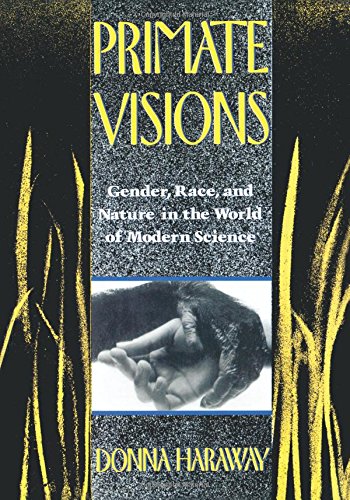Donna Haraway: Primate Visions: Gender, Race, and Nature in the World of Modern Science (1989)
Filed under book | Tags: · animal, biology, capitalism, family, feminism, gender, history of science, human, man, monkey, nature, primatology, race, science, sex, sexuality, technology, theory, women

“Haraway’s discussions of how scientists have perceived the sexual nature of female primates opens a new chapter in feminist theory, raising unsettling questions about models of the family and of heterosexuality in primate research.”
This “large book may be read from start to finish as a chronological and thematic survey of twentieth-century primatology. … But each chapter is simultaneously history of science, cultural studies, feminist exploration, and engaged intervention into the constitutions of love and knowledge in the disciplined crafting of the Primate Order. … My placing this account of primatology within SF–the narratives of speculative fiction and scientific fact–is an invitation for the readers of Primate Visions–historians, culture critics, feminists, anthropologists, biologists, anti-racists, and nature lovers–to remap the borderlands between nature and culture.” (from the Introduction)
Publisher Routledge, 1989
ISBN 0415902940, 9780415902946
ix+486 pages
Reviews: George E. Marcus (Science 1990), Alison Jolly and Margaretta Jolly (New Scientist 1990), Robin Dunbar (NY Times 1990), Louise Krasniewicz and Michael Blitz (Discourse 1990), Anne Fausto-Sterling (J Hist Biology 1990), Susan Cachel (Am J Primatology 1990), Meredith F. Small (Am J Physical Anthropology 1990), Sarah Franklin (J Hist Sexuality 1990), Matt Cartmill (Int J Primatology 1991), M. Lynn Byrd (H-Ideas 2001).
PDF (48 MB, added on 2021-3-10)
EPUB (3 MB)
Robert Rosen: Essays on Life Itself (1999)
Filed under book | Tags: · algorithm, anticipation, biology, causality, complex systems, complexity, environment, life, machine, mathematics, mind, philosophy of science, physics, science, semantics, systems theory, technology, theory

“In this collection of twenty-two essays, Rosen takes to task the central objective of the natural sciences, calling into question the attempt to create objectivity in a subjective world. The book opens with an exploration of the interaction between biology and physics, unpacking Schrödinger´s famous text What Is Life? and revealing the shortcomings of the notion that artificial intelligence can truly replicate life.
He also refutes the thesis that mathematical models of reality can be reflected entirely in algorithms, that is, are of a purely syntactical character. He argues that it is the noncomputable, nonformalizable nature of biology that makes organisms complex, and that these systems are generic, whereas those systems described by reductionistic reasoning are simple and rare.
An intriguing enigma links all of the essays: ‘How can science explain the unpredictable?'”
Publisher Columbia University Press, 1999
Complexity in Ecological Systems series
ISBN 023110510X, 9780231105101
x+360 pages
Reviews: Bruce J. West (Quarterly Review of Biology, 2001), Donald C. Mikulecky (c1999).
PDF (removed on 2019-10-30 upon request from Judith Rosen)
Comment (0)Marga Bijvoet: Art as Inquiry: Toward New Collaborations Between Art, Science, and Technology (1997) [EN, DE]
Filed under book | Tags: · 1960s, 1970s, art, art and science, art history, art theory, artistic research, ecology, environment, land art, media art, science, site-specific art, systems art, technology, video, video art

“Art as Inquiry is a pioneering yet under-recognized monographic study of art in the 1960s and early 1970s; Despite the subtitle, Bijvoet’s artistic concerns are not exclusively focused on science and technology, but rather with the “‘moving out’ into nature or the environment and the “moving ‘into technology’”: twin tendencies that, in her mind, stand out amidst the pluralism of 1960s art. She claims that these movements not only broke “the boundaries of art and … the commercial art world structure” but more importantly that environmental artists and tech artists both sought out and engaged in collaborations in which the artist “entered into a new relationship with the environment, space, public arena, onto the terrain of other sciences.”” (Edward A. Shanken)
Publisher Peter Lang, 1997
ISBN 0820433829, 9780820433820
x+283 pages
Review: Alan Dorin (2006).
WorldCat (EN)
Art as Inquiry (English, 1997, HTML, at Internet Archive)
Kunst-Forschung (German, n.d., HTML, at Internet Archive)

